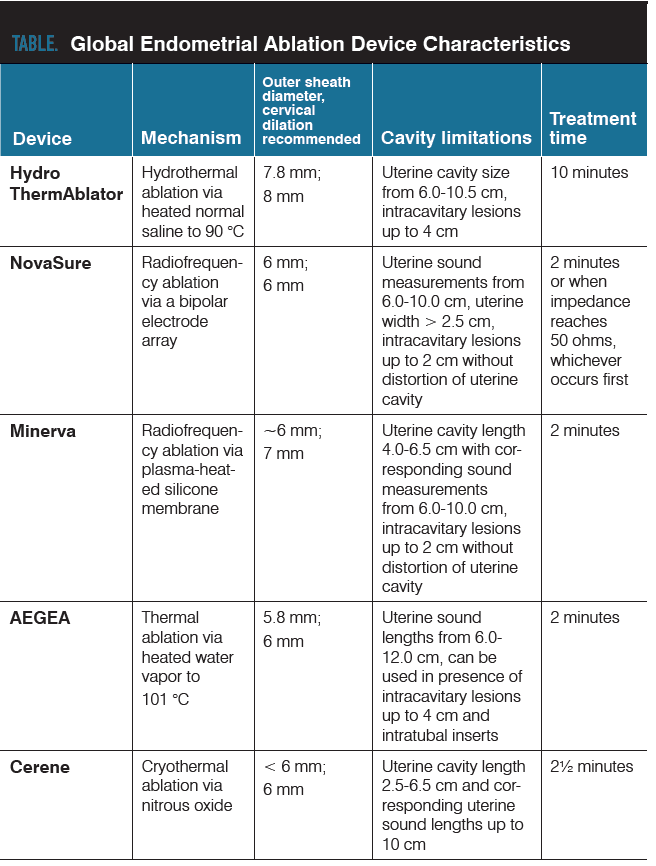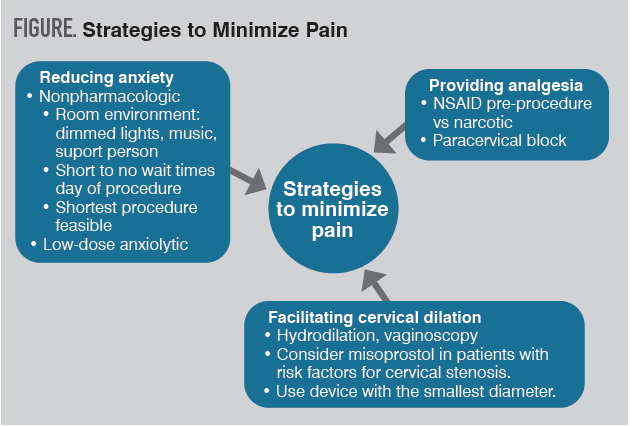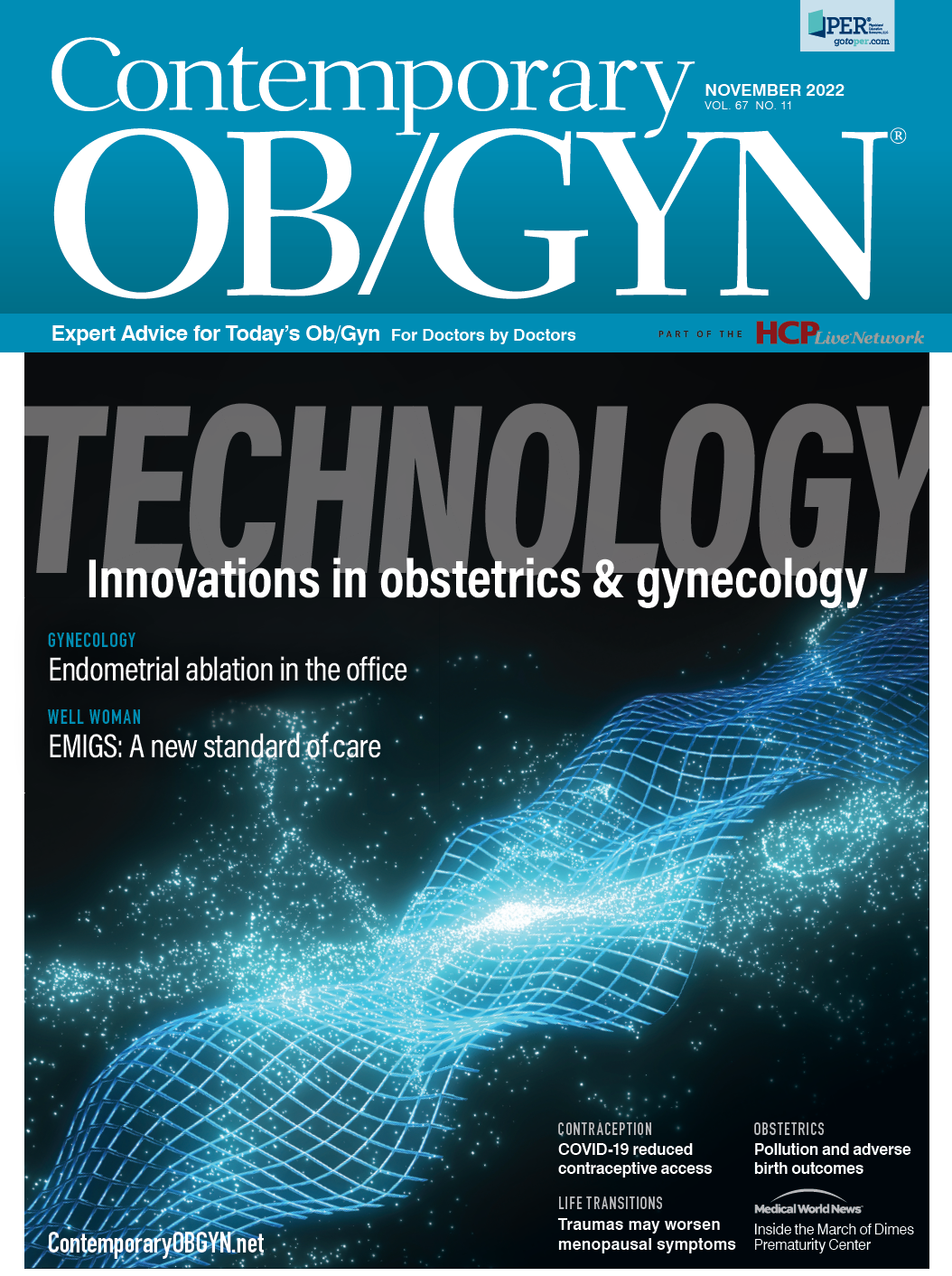Endometrial ablation in the office setting
Breaking down barriers through patient selection, new devices, and the latest techniques.
Heavy menstrual bleeding (HMB) affects over 20% of women.1 Endometrial ablation as a treatment for HMB, first reported in the 1980s, has evolved with global endometrial ablation devices dominating the market since the mid-1990s. With their introduction, office procedures became feasible.2 In 2008, a prospective cohort study found that endometrial ablation can be performed successfully in the physician’s office under local anesthesia and oral anxiolytics with low patient pain scores, high tolerability, and high patient satisfaction.3 However, many physicians have perceived barriers to offering and performing office endometrial ablation. We hope to break down some of these barriers by discussing patient selection, the available devices, and techniques to reduce patient pain and anxiety.
Patient selection
The ideal endometrial ablation candidate is a premenopausal patient 40 to 45 years or older with HMB of benign etiology and no major structural abnormality or coagulopathy. This patient has completed childbearing, has a reliable method of contraception, is without significant dysmenorrhea, and has a uterine cavity size less than 10 cm. 4-6
The success of endometrial ablation in the office setting depends upon choosing the patient best suited for this location. Physicians should adhere to state and local guidelines for office procedures. The American College of Obstetricians and Gynecologists (ACOG) has also developed checklists for Safety Certification in Outpatient Practice Excellence. The ACOG task force recommends that patients undergoing office-based procedures be limited to the American Society of Anesthesiologists (ASA) classification of 1 (healthy patient) or 2 (mild systemic disease).7
Notable examples of patients who do not fit these ASA 1 and 2 classifications include those with poorly controlled diabetes or hypertension, morbid obesity with body mass index greater than 40, chronic obstructive pulmonary disease or other moderate lung disease, alcohol dependence or abuse, or history of a cardiac event.8 In addition to patient classifications, there are different levels of anesthesia. With minimal sedation or level 1, the patient is normally responsive and doesn’t receive any anesthesia other than minimal preoperative anxiolysis in conjunction with local anesthesia. Level 2 includes the use of intravenous (IV) medications for sedation and because of this, intra- and postoperative monitoring is recommended. Regardless of the level of anesthesia planned, patients can reach a deeper level of sedation than intended and emergency equipment and skill for resuscitation should
be available.9
Device selection
All the currently available global endometrial devices can be used in office or operating room settings. They are operator friendly without a steep learning curve. We outline below the devices, how they work, and why—or why not—you may choose to use them in your office (Table).

Hydro ThermAblator System
The only hysteroscopic guided global endometrial ablation system, the Hydro ThermAblator System (HTA) has been approved by the FDA for heavy menstrual bleeding since 2001. The HTA components are assembled to a standard hysteroscope and the procedure consists of 2 phases: the 2-minute initial priming phase, during which room-temperature, normal saline is infused and cavity inspection occurs, and the 10-minute active treatment phase, during which saline is heated to90 °C. Following this, a posttreatment flush phase occurs for approximately 1 minute that rapidly reduces the temperature of the fluid so that it is safe for removal from the patient.10
A benefit of this system in the office is the hysteroscopic guided component. The video analgesia that HTA provides may be beneficial for some patients. The use of a fluid to ablate the cavity allows treatment in the setting of an abnormally shaped uterine cavity and polyps or a fibroid up to 4 cm. A retrospective cohort analysis of 246 patients undergoing HTA published in 2009, found that hydrothermal ablation performed in the medical office using local anesthesia is a safe, effective, and cost-saving procedure for treatment of abnormal uterine bleeding in women with both normal and myomatous uteri.11 The major drawback of the HTA system for use in the office is the length of the procedure, which lasts at least 12 minutes.
NovaSure Endometrial Ablation
FDA approved since 2001, the NovaSure endometrial ablation system works through radiofrequency ablation, during which a bipolar electrode array delivers electrical energy to the endometrium, causing vaporization of the tissue. The power provided to the device by the radiofrequency controller depends on the measurements (cervical canal length, cavity length, cavity width) set on the device and radiofrequency controller. The procedure terminates when the impedance at the tissue electrode interface reaches
50 ohms or when the total treatment time reaches 2 minutes, whichever comes first. Prior to initiating ablation, a cavity integrity assessment is performed using CO2 gas to ensure no perforation has occurred.12
Studies examining the pain experienced by patients undergoing this procedure in the office have found that it is feasible. However, the pain experience, while tolerable, may be a disadvantage. A randomized control trial from 2016 compared bipolar radiofrequency ablation and balloon thermal endometrial ablation using the visual analog scale to measure pain during the procedure. Four women developed a vasovagal reaction during the procedure. Median pain scores were 3.0 (range, 1.0-7.0) during dilation and 5.1 (range, 0.0-10.0) for the entire procedure.13 In another study, Kalkat and Cartmill assessed the feasibility and efficacy of using the NovaSure device with local anesthesia in 50 women. All procedures were completed and 94% of women were discharged on the same day as their procedure. However, 3 women required overnight admission for pain relief and 14% of patients treated indicated they would have preferred to undergo the procedure with general anesthesia.14
Minerva Endometrial Ablation
The Minerva endometrial ablation system is a somewhat more recent option and was FDA approved in 2015. The Minerva uses argon plasma technology with a silicone array to ablate via tissue-penetrating bipolar radio-frequency energy, direct contact thermal ablation from membrane to tissue, and thermal ablation using the heated liquids present within the uterine cavity. Its uterine integrity test with CO₂ is similar to the NovaSure and treatment time is 2 minutes.15
Overall, the benefits and disadvantages of Minerva’s use in the office are comparable to the NovaSure. One aspect of the Minerva that might enhance patient experience in an office setting is the silicone array. Post ablation it may be less likely to adhere to the endometrium compared with the NovaSure, thereby causing less discomfort upon removal.
AEGEA Vapor System
The AEGEA Vapor System, approved by the FDA in 2017, uses heated water vapor to ablate the endometrium. The vapor probe is inserted into the uterine cavity and 3 balloons are inflated to seal the uterine cavity. A uterine cavity integrity test is performed to ensure no perforations have occurred, followed by a device lumen patency test to verify that tissue or blood does not block the lumen. Vapor is then delivered into the uterus for 140 seconds, with a treatment time of 2 minutes. Following treatment, the balloons automatically deflate, and the probe is removed.16
A primary advantage of the AEGEA system is the additional patient selection it provides. It can accommodate uterine cavity lengths of up to 12 cm and the presence of uterine myomas less than or equal to 4 cm or intratubal contraceptive inserts.
Cerene Cryotherapy Device
FDA approved since 2019, the Cerene device is the newest global endometrial ablation device available. It uses nitrous oxide (N₂O) to perform a cryothermal endometrial ablation. Following the device prompts, it is inserted into the uterine fundus, the thin polyurethane liner is deployed, and once an initial preset pressure is reached, an outer sheath is retracted to meet the size of the premeasured cavity length. Treatment is initiated with the press of a button. Once the safety checks are completed, N₂O flow automatically begins and lasts for 2½ minutes. Following treatment, the N₂O is evacuated, thawing occurs, and the device is removed.17
The Cerene device was specifically developed to be used in an office setting with limited requirement for anesthesia. Cryoanalgesia, using extreme cold to freeze nerves, is the basis for minimizing pain with this procedure. In a prospective clinical trial from 2020 examining the safety and effectiveness of the Cerene endometrial ablation in the office/procedure room setting found that pain was mild during the entire procedure, ranging from 0 to 2 on a 10-point scale. Ninety-seven percent of subjects were treated with a paracervical block and an oral medication [narcotic, anxiolytic, or nonsteroidal anti-inflammatory drug (NSAID)] for anesthesia/analgesia during the procedure. Three percent of subjects received IV sedation.18
Minimizing pain in office endometrial ablation
Fear regarding insufficient pain control is often a barrier to performing office procedures. Heightened anxiety can worsen pain and thus strategies to reduce anxiety are essential elements of successful office procedures.19 This can start with the environment of the room—dimmed lights and allowing the patient’s support person to sit with them. In a procedure that often feels invasive to patients, it’s important to remind them that they are in control of their body and the exam.
Additionally, studies have found that playing music during the procedure and reducing preprocedural waiting times have been associated with decreased anxiety and pain perception in office procedures.20 A low-dose anxiolytic can be considered in conjunction with these nonpharmacologic strategies for patients with severe anxiety (Figure).

No single analgesic regimen has been found to be the gold standard. It often depends on patient tolerance and provider preference and significant variation exists among gynecologists.21 The primary choice physicians encounter is between an NSAID and a narcotic, or a combination of the 2. Most studies examining analgesia in office gynecologic procedures is for office hysteroscopy, with little data comparing analgesia regimens for endometrial ablation.
These data are helpful as diagnostic hysteroscopy is often performed just prior to endometrial ablation. A randomized control trial from 2016 comparing tramadol vs celecoxib for reducing pain in outpatient hysteroscopy found no difference in pain among the groups with slightly more adverse effects noted in the tramadol group.22 A literature review from 2020 examining effective analgesia for women undergoing office hysteroscopy found that taking an oral NSAID prior to the procedure was associated with significantly reduced pain scores23 while a separate literature review published in 2022 concluded that NSAID administration before office hysteroscopy is not efficient in reducing pain during the procedure while tramadol is a safe and efficient option for pain reduction.24
Most studies have found improved patient outcomes with paracervical block (PCB). There are many slight variations on exactly how to perform a PCB ,but the overall goal is to block transmission of pain through sympathetic, parasympathetic, and visceral sensory fibers of the uterovaginal plexus before they enter the uterus at the level of the internal os.25 This is accomplished by injecting a total of 10 to 20 ml of short-acting local anesthetic bilaterally at the level of the cervicovaginal junction, usually around 4 and 8 o’clock, avoiding vessels at 3 and 9 o’clock.
During office procedures, more instrumentation is associated with increased pain. Thus, each step should be intentional and necessary. Smaller-diameter devices and shorter procedures have been shown to be associated with
less pain.26
The opinions on the use of misoprostol is mixed. Misoprostol is used to help in cervical softening and to lessen the discomfort of or even the need for mechanical dilation in gynecologic procedures is mixed. The patient population most likely to experience a reduction of pain are premenopausal nulliparous patients.27,28 A trial from 2017 found that misoprostol prior to office hysteroscopy did not confer improved pain outcomes in patients with no risk factors for cervical stenosis (parous women of reproductive age who had no history of cesarean section or cervical surgery).29 A preprocedural oral or vaginal 200-microgram dose of misoprostol can be considered in patients who have a risk factor for cervical stenosis or are nulliparous.
Conclusion
Performing endometrial ablations in the office over the operating room confers the benefits of less time required for the patient and physician, decreased financial burden, and avoiding the risk of general anesthesia. Physicians can safely move most of these procedures to their office by following the principles we have described.
- References
Heavy menstrual bleeding. Centers for Disease Control and Prevention. Updated August 17, 2022. Accessed September 30, 2022. https://www.cdc.gov/ncbddd/blooddisorders/women/menorrhagia.html - Glazerman LR. Endometrial ablation as a treatment for heavy menstrual bleeding. Surg Technol Int. 2013;23:137-141.
- Chapa H. Utility of in-office endometrial ablation: a prospective cohort study of endometrial ablation under local anesthesia. J Reprod Med. 2008;53(11):827-831.
- Klebanoff J, Makai GE, Patel NR, Hoffman MK. Incidence and predictors of failed second-generation endometrial ablation. Gynecol Surg. 2017;14(1):26. doi:10.1186/s10397-017-1030-4
- Smith PP, Karpate S, Clark TJ. Prognostic factors that predict success in office endometrial ablation: a retrospective study. Gynecol Surg. 2016;13:83-87. doi:10.1007/s10397-015-0921-5
- Wortman M. Late-onset endometrial ablation failure. Case Rep Womens Health. 2017;15:11-28. doi:10.1016/j.crwh.2017.07.001
- Erickson TB, Kirkpatrick DH, DeFrancesco MS, et al. Executive summary of the American College of Obstetricians and Gynecologists Presidential Task Force on patient safety in the office setting: reinvigorating safety in office-based gynecologic surgery. Obstet Gynecol. 2010;115(1):147-151.
- American Society of Anesthesiologists. ASA Physical Status Classification System. Updated December 13, 2020. Accessed October 1, 2022.https://www.asahq.org/standards-and-guidelines/asa-physical-status-classification-system
- Peacock, LM, Thomassee ME, Williams VL, Young AE. Transition to office-based obstetric and gynecologic procedures: safety, technical, and financial considerations. Clin Obstet Gynecol. 2015;58(2):418-433 doi:10.1097/GRF.0000000000000100
- Summary of safety and effectiveness data: Hydro ThermAblator Endometrial Ablation System P000040. FDA. Accessed October 17, 2022. https://www.accessdata.fda.gov/cdrh_docs/pdf/P000040b.pdf
- Glasser MH, Heinlein PK, Hung YY. Office endometrial ablation with local anesthesia using the HydroThermAblator system: comparison of outcomes in patients with submucous myomas with those with normal cavities in 246 cases performed over 5(1/2) years. J Minim Invasive Gynecol. 2009;16(6):700-707. doi:10.1016/j.jmig.2009.06.023
- Summary of safety and effectiveness data: NovaSure Impedance Controlled Endometrial Ablation System P010013. FDA. Accessed October 17, 2022. https://www.accessdata.fda.gov/cdrh_docs/pdf/P010013b.pdf
- Penninx JP, Herman MC, Kruitwagen RF, Ter Haar AJ, Mol BW, Bongers MY. Bipolar versus balloon endometrial ablation in the office: a randomized controlled trial. Eur J Obstet Gynecol Reprod Biol. 2016;196:52-56. doi:10.1016/j.ejogrb.2015.10.010
- Kalkat RK, Cartmill RS. NovaSure endometrial ablation under local anaesthesia in an outpatient setting: an observational study. J Obstet Gynaecol. 2011;31(2):152-155. doi:10.3109/01443615.2010.538772
- Summary of safety and effectiveness data: Minerva Endometrial Ablation System P140013. FDA. Accessed October 17, 2022. https://www.accessdata.fda.gov/cdrh_docs/pdf14/p140013b.pdf
- Summary of safety and effectiveness data: AEGEA Vapor System P160047. FDA. https://www.accessdata.fda.gov/cdrh_docs/pdf16/P160047B.pdf
- Summary of safety and effectiveness data: Cerene Cryotherapy Device P180032. FDA. Accessed October 17, 2022. https://www.accessdata.fda.gov/cdrh_docs/pdf18/P180032B.pdf
- Curlin HL, Cintron LC, Anderson TL. A prospective, multicenter, clinical trial evaluating the safety and effectiveness of the Cerene device to treat heavy menstrual bleeding. J Minim Invasive Gynecol. 2021;28(4):899-908. doi:10.1016/j.jmig.2020.08.013
- Del Valle C, Antonio Solano J, Rodriguez Miguel J, Alonso M. Pain management in outpatient hysteroscopy. Gynecol Minim Invasive Ther. 2016;5(4):141-147. doi:10.1016/j.gmit.2016.08.001
- Sorrentino F, Petito A, Angioni S, et al. Impact of anxiety levels on the perception of pain in patients undergoing office hysteroscopy. Arch Gynecol Obstet. 2021;303(4):999-1007. doi:10.1007/s00404-020-05885-9
- Barlow DH. Optimizing office hysteroscopy. Fertil Steril. 2019;111(3):465-466. doi:10.1016/j.fertnstert.2018.12.001
- Hassan A, Wahba A, Haggag H. Tramadol versus celecoxib for reducing pain associated with outpatient hysteroscopy: a randomized double-blind placebo-controlled trial. Hum Reprod. 2016;31(1):60-66. doi:10.1093/humrep/dev291
- De Silva PM, Stevenson H, Smith PP, Justin Clark T. A systematic review of the effect of type, pressure, and temperature of the distension medium on pain during office hysteroscopy. J Minim Invasive Gynecol. 2021;28(6):1148-1159.e2. doi:10.1016/j.jmig.2021.01.003
- Buzzaccarini G, Alonso Pacheco L, Vitagliano A, et al. Pain management during office hysteroscopy: an evidence-based approach. Medicina (Kaunas). 2022;58(8):1132. doi:10.3390/medicina58081132
- Vitale SG, Alonso Pacheco L, Haimovich S, et al. Pain management for in-office hysteroscopy. A practical decalogue for the operator. J Gynecol Obstet Hum Reprod. 2021;50(1):101976. doi:10.1016/j.jogoh.2020.101976
- De Silva PM, Stevenson H, Smith PP, Clark TJ. Pain and operative technologies used in office hysteroscopy: a systematic review of randomized controlled trials.
- Tasma ML, Louwerse MD, Hehenkamp WJ, et al. Misoprostol for cervical priming prior to hysteroscopy in postmenopausal and premenopausal nulliparous women; a multicentre randomised placebo controlled trial. BJOG. 2018;125(1):81-89. doi:10.1111/1471-0528.14567
- Nair VG, Roy KK, Rai R, Das A, Bharti J, Zangmo R. Effectiveness of misoprostol in office hysteroscopy in premenopausal nulliparous women: a prospective randomized double-blind placebo-controlled trial. J Hum Reprod Sci. 2020;13(2):104-109. doi:10.4103/jhrs.JHRS_149_19
- Fouda UM, Elsetohy KA, Elshaer HS, et al. Misoprostol prior to diagnostic office hysteroscopy in the subgroup of patients with no risk factors for cervical stenosis: a randomized double blind placebo-controlled trial. Gynecol Obstet Invest. 2018;83(5):455-460. doi:10.1159/000480234

